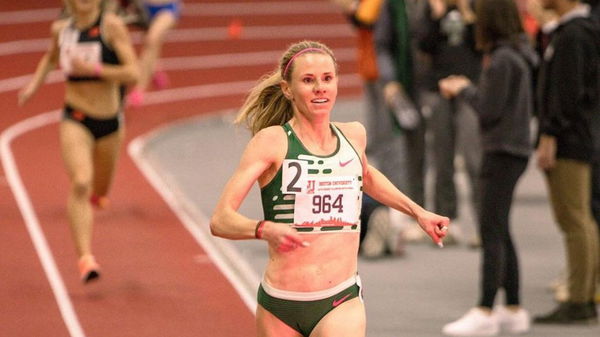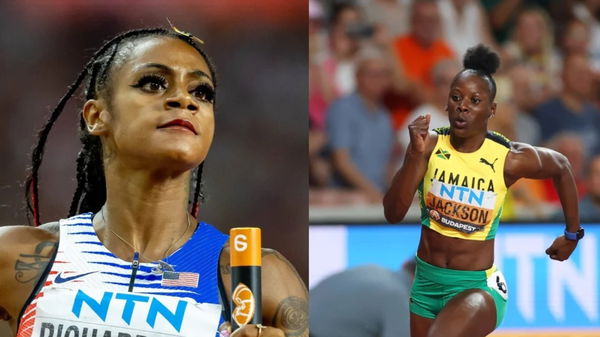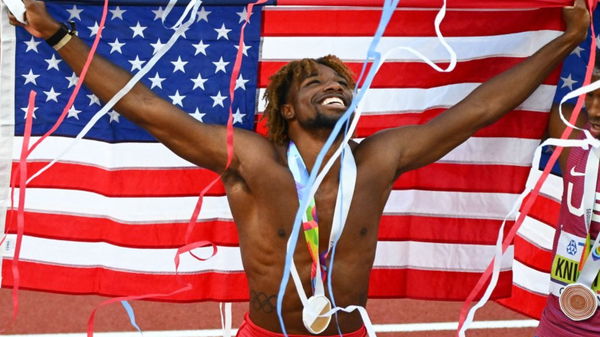
More TRACK AND FIELD News
Paris Olympics: Major Heartbreak for America as Track and Field Community’s Hopes Crushed Over Courtney Frerichs’ Injury
US middle-distance runners Emma Coburn and Courtney Frerichs face season-ending injuries, jeopardizing Olympic hopes for Paris.

Conquering Atlanta Games, Noah Lyles and Brother Deliver on Their Promise to Track and Field Community
Noah Lyles combines Olympic prowess with dedication, hosting the Union Athletics/Lyles Foundation Invitational to inspire young athletes.

Sha’Carri Richardson Falling Out of Ranks Against Jamaican Rival Shericka Jackson After She Takes Home Rabat Diamond League Victory
Shericka Jackson earns the top podium in the trademark 200m event while arch-rival Sha'Carri Richardson is yet to get a top finish.

“Disrespectful Behaviour”: Tara Davis-Woodhall Leaves Track and Field Community Fuming Over Unnecessary Atlanta Games Move
In a playful moment that sparked ire among spectators, Tara Davis-Woodhall lightheartedly challenged a referee's foul call.

Dark Clouds Over Track & Field Community as Letsile Tebogo Loses Mother To Longtime Illness
Jamaica’s Letsile Tebogo suffers a personal loss ahead of the Paris Olympics as his mother passes away. Fans and media express condolences.

Not Noah Lyles, “Man of the People” Steals Track and Field Fans’ Love at Atlanta Games
Grant Holloway shines at the 2024 Adidas Atlanta City Games, winning hearts with his 110m hurdles performance and fan interactions.

Gabby Thomas Directly Addresses Track and Field Community’s Concerns Over Disappointing Performance
Gabby Thomas' track challenges and Olympic aspirations amid a competitive field reveal the journey of a determined athlete.

Gabby Thomas Dives Into 776 Invitational’s Alexis Ohanian’s Approach to Biggest Track and Field Purse Event
Gabby Thomas was one of the initial names announced for the 776 Invitational, which is set to feature other major T&F stars.

Not Just Final Race, Noah Lyles Also Won Over POTUS Visit at Atlanta Games
Snatching the limelight from The President's visit, Noah Lyles picks up major victory at the Atlanta City Games 2024, defeats Zharnel Hughes.

Sydney McLaughlin-Levrone’s Coach Possibly Forced for Huge Paris Olympics Risk After 200M USATF Grand Prix Win
Sydney McLaughlin-Levrone will run only in the 400m hurdle in the Paris Olympics as her coach, Bobby Kersee has decided.

Sha’Carri Richardson Falling out of Ranks Against Sydney McLaughlin-Levrone After the USATF Grand Prix 2024
Following the USATF Grand Prix 2024, Sha’Carri Richardson has slipped behind Sydney McLaughlin-Levrone in the rankings.

Sha’Carri Richardson’s Loss Avenged by US Track & Field Athlete as Daryll Neita Accepts Atlanta Games Defeat
Candace Hill triumphs over Daryll Neita in the Atlanta City Games, showcasing her sprinting prowess with a record-setting 150m win.

About TRACK AND FIELD
Track and Field: History and evolution of the sport
On the marks, set, go. If only the evolution of track and field were so easy. Instead, it was something that gradually happened over years of evolution.

Ancient- One of the oldest sports to have existed, the cornerstone of track and field was laid by the Greeks, where men would exhibit their athletic talents as part of celebratory events. Initially limited to foot races, stadion and diaulos were the competitions that comprised the crux of the sport, which has been around since the first Olympics in Ancient Greece, dating back to 776 B.C. Although the Romans continued the games till 394 A.D., when it was banned, the sport saw a resurgence after the decline of the Roman empire. Tracing back to the 16th and 17th centuries, foot races had become a regular sight in Europe.
Modern- The 1860s predominantly saw the wave of transformation, wherein the first championships featuring amateur men were held in England. Athletic clubs and organizations sprung up across Europe and the United States, with the Amateur Athletic Union (AAU) coming into being in 1887.
Olympic age- 1896, was when the first Modern Olympic Games were flagged off in Athens, which included track and field in the sports that debuted.
20th century- With athletes flocking from across the world to exhibit their athletic talent, track and field's stature elevated substantially. Technical developments fostered improvements in training and diet, and the track saw the likes of legends like Jesse Owens, Usain Bolt, Flo-Jo, etc coming out at the top.
What are the major events in track and field?
Track and field is a sport that covers a plethora of events under its banner. Speaking of the Olympics in particular, it features 48 events, 24 men's events and 24 women's. Care to know what they are?
| Track Discipline | Events |
| Sprint | 100m, 200m, 400m |
| Middle-distance/Long-distance | 800m, 1500m, 5000m, 10000m, 3000m steeplechase |
| Hurdles | 100m hurdles, 110m hurdles, 400m hurdles |
| Road Running | Half marathon, marathon |
| Race Walks | 20k race walk, 35k race walk |
| Relays | 4x100 relay, 4x400 relay, 4x400 relay mixed |
| Field Discipline | Events |
| Jumps | High jump, pole vault, long jump, triple jump |
| Throws | Shot put, discus throw, hammer throw, javelin throw |
| Combined Events | Heptathlon, Decathlon |
| Cross Country | |
| Mountain Running | |
| Ultra Running | |
| Trail Running |

What are the rules and regulations of track and field in major competitions like the Olympics?
Sprinting Rules
- Most of the sprinting events from 100m to 5000m conduct qualifying rounds before the finals. Usually heats, semifinals, and then the finals. The top three on the finals scoreboard take home gold, silver, and bronze.
- Sprints, hurdles, and relay races feature starting blocks, followed by the firing of a pistol to commence the race. If a runner starts before the fire, it's called a 'false start.' This will lead to disqualification.
- 100m sprints and 110m/100m hurdles comprise starts where racers are all in one line. Whereas, in the 200m, 400m, 400m hurdles, 4x100m relay, and 400m relay categories, they are placed in staggered positions.
- Running outside the allocated lanes would also lead to disqualification. If an athlete is forced to cross the lane by another one so that there is no material advantage, they will not be disqualified. The same for a person who strays out or crosses the line, and in doing so, they do not get an advantage, there will be no disqualification.
- The athlete whose torso crosses the vertical finish line plane will be declared the winner.
- For any of the relays, baton handover must not happen beyond the 20m changeover box. If yes, then this would amount to disqualification.
- The baton should not fall or touch the ground in any way.
- There are no starting blocks in these races. Also, athletes line up in an upright position. In 800m, the 8 runners will stand in staggered positions before the start. Through the first turn, they have to stay in their respective lanes, but can then break to the inside. If done very early, then can lead to disqualification.
- 1500m and the steeplechase have group starts, and no fixed lanes are allocated.
- In steeplechase, if an athlete steps aside during a barrier, they will be disqualified. They can jump above them in any way, but no part of the foot or leg should be below the horizontal plane of the upper bar while they are attempting to clear it.
- The 10,000m, marathon, race walk, decathlon, and heptathlon are events that directly conduct finals with no qualifying rounds.
- The starts happen in an upright position and involve no touching of the ground.
- Usually, these feature mass starts. However given the possibility that there are more than 12 runners in the race, they are divided into staggered groups. The first one will have 65 percent of the athletes that usually appear on a start line.
- There are no lane assignments. Track athletes can break for positions right after the commencement.
- The walker must be in contact with the ground continuously. Even the advancing leg should be straight from the instance when it comes in contact with the ground till it goes into the upright position.
- There are anything between six and nine judges in the event. And they are free to issue warnings upon violations like leg contact or perhaps a bent knee.
- If participating athletes get warnings from 3 different judges, they get disqualified. Also, if an official medical officer asks them to retire from the race, the competitors must leave.
- High jump- The jump-off must happen from one foot. And given that the athlete makes contact with the crossbar and falls off the supports, it will be counted as a failed attempt. Also, athletes will be given 3 attempts for a particular height. The option to pass a certain height and try for the next is also available. But, if there are 2 failed attempts at a single height, and the athlete skips that to move on to the next, the next should be cleared on the first try.
- Pole Vault- Participants can use a substance either on their hands or the pole to facilitate a better grip. But, tape on fingers or hands is prohibited, unless there is an open wound. Athletes are also allowed to use their poles, of any material, length, or diameter. If they break, the participants still get another go at it. However, there are three criteria for disqualification. First is when the vaulter makes the crossbar fall by touch. Second is when they move their lower hand above their upper one or their upper hand higher on the pole after leaving the ground. And third, if they steady or replace the bar while conducting the vault.
- Long Jump- The measurement for the jumps is calculated from the takeoff line to the closest break in the landing area, done by any part of the participant's body. Failed attempts happen on exceeding the takeoff line while jumping, or on taking off from outside either end of the take-off board. Or perhaps touching the ground outside the landing area closer to the take-off line, in comparison to the nearest break in the sand.
- Triple Jump- There are three stages of a triple jump- a hop, a step, and a jump, all done in the said sequence. Hope and jump have to be made from the same foot used for take-off, while the step involves the other. Failed attempts have identical criteria to the long jump. However, there is one exception, and that is when an athlete makes contact with the ground with their sleeping leg during a jump, it isn't considered a failure.
- The decathlon and heptathlon events are conducted over two consecutive days.
- In both these events, 3 attempts in the long jump, shot put, discus, and javelin throw are allowed. And a single false start in track events is allowed.
- Shot, discuss, and hammer throw are all done from within the demarcated throwing circles. While the javelin throw features a runway. Crossing either while a throwing attempt is made will count as a failed attempt.
- Also, the athletes must not exit and stay in the throwing area until the javelin or the respective implement touches the ground. And for it to be considered a valid throw, they should land within the landing zone.
- Gloves are only permitted in hammer throw, while any sort of tape is not allowed unless there is an open wound on the hands or the fingers.

via Getty
EUGENE, OREGON - JUNE 18: Ryan Crouser competes in the Men's Shot Put final during day one of the 2020 U.S. Olympic Track & Field Team Trials at Hayward Field on June 18, 2021 in Eugene, Oregon. (Photo by Andy Lyons/Getty Images)
What are the major track and field championships?
Some of the pivotal athletic competitions include-
- The Athletics World Championships (Once every 2 years)
- Olympic Games (Once every 4 years)
- Commonwealth Games (Once every 4 years)
- World Indoor Championships (Once every 2 years)
- World Diamond League Meetings (Every year)
- World Athletics Relays (Biennial)
- Marathon Majors (Every year)
- World Athletics Cross Country Championships (Biennial)
- New York Marathon (Every year)
Who are the greatest track and field stars of all time?
Here are some of the most decorated track and field athletes of all time:
| Name | Country | Event | Olympic medals | Personal best |
| Paavo Nurmi | Finland | Middle and Long Distance Runner | 12 medals- 9G, 3S | 10000m - 30:06.2h 3000m - 8:20.4h 5000m- 14:28.2h |
| Carl Lewis | United States
| 100m,200m, Long Jump, 4x100m relay | 10 medals- 9G, 1S | Long Jump- 8.87 100m- 9.86 200m- 19.75 |
| Usain Bolt | Jamaica | 100m, 200m, 4x100m relay | 8 medals- 8G | 100m- 9.58 (WR, AR) 200m- 19.19 (WR, AR) |
| Jesse Owens | United States | 100m, 200m, Long Jump, 4x100m relay | 4 medals- 4G | 100m- 10.2h 200m- 20.7h 4x100m relay- 39.8h Long Jump- 8.13 |
| Allyson Felix | United States | 200m, 4x400m relay, 4x100m relay, 400m | 11 medals- 7G, 3S, 1B | 200m- 21.69 400m- 49.26 4x100m relay- 40.82 4x400m relay- 31.16.85 |
| Florence Griffith Joyner | United States | 100m, 200, 4x100m relay, 4x400m relay | 5 medals- 3G, 2S | 100m- 10.49 200m- 21.34 |

via Getty
Usain Bolt of Jamaica reacts as he wins the Olympic mens 200m final in a new world record time in the Birds Nest stadium, Beijing on August 20th 2008 in Beijing, China (Photo by Tom Jenkins/Getty Images). An image from the book "In The Moment" published June 2012
| Jackie Joyner-Kersee | United States | Heptathlon, Long Jump | 6 medals- 3G, 1S, 2B | Heptathlon- 1331 Long Jump- 7.49 |
| Bob Beamon | United States | Long Jump | 1 medal- 1G | Long Jump- 8.90 |
| Javie Sotomayor | Cuba | High Jump | 2 medals- 1G, 1S | High Jump- 2.45 (WR) |
| Jan Zelezny | Czechia | Javelin Throw | 4 medals- 3G, 1S | Javelin Throw- 98.48 (WR) |
| Haile Gebrselassie | Ethiopia | Long Distance Runner | 2 medals- 2G | 10000m- 26:22.75 5000m- 12:39.36 |
| AI Oerter | United States | Discus Throw | 4 medals- 4G | Discus Throw- 69.46 |
| Sergey Bubka | Ukraine | Pole Vault | 1 medal- 1G | Pole Vault- 6.15 |

